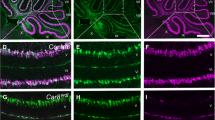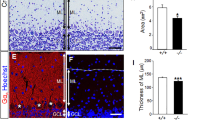Abstract
The calcium-binding protein S100B has been shown to support neuron proliferation, migration and neurite growth in vitro, while the significance of S100B for neuronal development in vivo is controversial. We have investigated the effect of S100B deficiency on cerebellar development in S100B knockout mice at an age of 5 and 10 days after birth (P5 and P10). This time range covers important developmental steps in the cerebellum such as granule cell proliferation and migration, as well as dendritic growth of Purkinje cells. Bergmann glial cells contain a particularly high concentration of S100B and serve as scaffold for both migrating granule cells and growing Purkinje cell dendrites. This renders the postnatal cerebellum ideal as a model system to study the importance of S100B for glial and neuronal development. We measured the length of Bergmann glial processes, the width of the external granule cell layer as a measure of granule cell proliferation, the decrease in width of the external granule cell layer between P5 and P10 as a measure of granule cell migration, and the length of Purkinje cell dendrites in wild-type and S100B knockout mice. None of these parameters showed significant differences between wild-type and knockout mice. In addition, wild-type and knockout mice performed equally in locomotor behaviour tests. The results indicate that S100B-deficient mice have normal development of the cerebellum and no severe impairment of motor function.





Similar content being viewed by others
References
Donato R, Cannon BR, Sorci G, Riuzzi F, Hsu K, Weber DJ, et al. Functions of S100 proteins. Curr Mol Med. 2013;13:24–57.
Marshak DR. S100 beta as a neurotrophic factor. Prog Brain Res. 1990;86:169–81.
Rothermundt M, Ahn JN, Jorgens S. S100B in schizophrenia: an update. Gen Physiol Biophys. 2009;28:F76–81.
Rothermundt M, Peters M, Prehn JHM, Arolt V. S100B in brain damage and neurodegeneration. Microsc Res Tech. 2003;60:614–32.
Steiner J, Bogerts B, Schroeter ML, Bernstein H. S100B protein in neurodegenerative disorders. Clin Chem Lab Med. 2011;49:409–24.
Peskind ER, Griffin WS, Akama KT, Raskind MA, van Eldik LJ. Cerebrospinal fluid S100B is elevated in the earlier stages of Alzheimer's disease. Neurochem Int. 2001;39:409–13.
Roche S, Cassidy F, Zhao C, Badger J, Claffey E, Mooney L, et al. Candidate gene analysis of 21q22: Support for S100B as a susceptibility gene for bipolar affective disorder with psychosis. Am J Med Genet. 2007;144:1094–6.
Donato R, Sorci G, Riuzzi F, Arcuri C, Bianchi R, Brozzi F, et al. S100B's double life: Intracellular regulator and extracellular signal. Biochim Biophys Acta. 2009;1793:1008–22.
Baudier J, Delphin C, Grunwald D, Khochbin S, Lawrence JJ. Characterization of the tumor suppressor protein p53 as a protein kinase C substrate and a S100b-binding protein. Proc Natl Acad Sci U S A. 1992;89:11627–31.
Brozzi F, Arcuri C, Giambanco I, Donato R. S100B Protein Regulates Astrocyte Shape and Migration via Interaction with Src Kinase: Implications for astrocyte development, activation, and tumor growth. J Biol Chem. 2009;284:8797–811.
Ikura M, Osawa M, Ames JB. The role of calcium-binding proteins in the control of transcription: structure to function. Bioessays. 2002;24:625–36.
Sorci G, Riuzzi F, Arcuri C, Tubaro C, Bianchi R, Giambanco I, et al. S100B protein in tissue development, repair and regeneration. WJBC. 2013;4:1.
Saleh A, Smith DR, Tessler L, Mateo AR, Martens C, Schartner E, et al. Receptor for advanced glycation end-products (RAGE) activates divergent signaling pathways to augment neurite outgrowth of adult sensory neurons. Exp Neurol. 2013;249:149–59.
Villarreal A, Aviles Reyes RX, Angelo MF, Reines AG, Ramos AJ. S100B alters neuronal survival and dendrite extension via RAGE-mediated NF-κB signaling. J Neurochem. 2011;117:321–32.
Buffo A, Rossi F. Origin, lineage and function of cerebellar glia. Prog Neurobiol. 2013;109:42–63.
Xu H, Yang Y, Tang X, Zhao M, Liang F, Xu P, et al. Bergmann glia function in granule cell migration during cerebellum development. Mol Neurobiol. 2013;47:833–44.
Heinsen H. Quantitative anatomical studies on the postnatal development of the cerebellum of the albino rat. Anat Embryol (Berl). 1977;151:201–18.
Komuro H, Yacubova E. Recent advances in cerebellar granule cell migration. Cell Mol Life Sci. 2003;60:1084–98.
Kapfhammer JP. Cellular and molecular control of dendritic growth and development of cerebellar Purkinje cells. Prog Histochem Cytochem. 2004;39:131–82.
Lordkipanidze T, Dunaevsky A. Purkinje cell dendrites grow in alignment with Bergmann glia. Glia. 2005;51:229–34.
Thyssen A, Stavermann M, Buddrus K, Doengi M, Ekberg JA, St John JA, et al. Spatial and developmental heterogeneity of calcium signaling in olfactory ensheathing cells. Glia. 2013;61:327–37.
Singaravelu K, Lohr C, Deitmer JW. Regulation of store-operated calcium entry by calcium-independent phospholipase A2 in rat cerebellar astrocytes. J Neurosci. 2006;26:9579–92.
Stavermann M, Buddrus K, St John JA, Ekberg JA, Nilius B, Deitmer JW, et al. Temperature-dependent calcium-induced calcium release via InsP3 receptors in mouse olfactory ensheathing glial cells. Cell Calcium. 2012;52:113–23.
Schneider CA, Rasband WS, Eliceiri KW. NIH Image to ImageJ: 25 years of image analysis. Nat Methods. 2012;9:671–5.
Deloulme JC, Gentil BJ, Baudier J. Monitoring of S100 homodimerization and heterodimeric interactions by the yeast two-hybrid system. Microsc Res Tech. 2003;60:560–8.
Lohr C, Heil JE, Deitmer JW. Blockage of voltage-gated calcium signaling impairs migration of glial cells in vivo. Glia. 2005;50:198–211.
Lohr C, Grosche A, Reichenbach A, Hirnet D. Purinergic neuron-glia interactions in sensory systems. Pflugers Arch. 2014;466:1859–72.
Rosenberg SS, Spitzer NC. Calcium signaling in neuronal development. Cold Spring Harbor Perspect Biol. 2011;3:a004259.
Deitmer JW, Verkhratsky AJ, Lohr C. Calcium signalling in glial cells. Cell Calcium. 1998;24:405–16.
Ciccarelli R, Di Iorio P, Bruno V, Battaglia G, D'Alimonte I, D'Onofrio M, et al. Activation of A1 adenosine or mGlu3 metabotropic glutamate receptors enhances the release of nerve growth factor and S-100beta protein from cultured astrocytes. Glia. 1999;27:275–81.
Pinto SS, Gottfried C, Mendez A, Goncalves D, Karl J, Goncalves CA, et al. Immunocontent and secretion of S100B in astrocyte cultures from different brain regions in relation to morphology. FEBS Lett. 2000;486:203–7.
Hanke S, Reichenbach A. Quantitative-morphometric aspects of Bergmann glial (Golgi epithelial) cell development in rats. A Golgi study. Anat Embryol (Berl). 1987;177:183–8.
Hachem S, Laurenson A, Hugnot J, Legraverend C. Expression of S100B during embryonic development of the mouse cerebellum. BMC Dev Biol. 2007;7:17.
Xiong Z, O'Hanlon D, Becker LE, Roder J, MacDonald JF, Marks A. Enhanced calcium transients in glial cells in neonatal cerebellar cultures derived from S100B null mice. Exp Cell Res. 2000;257:281–9.
Jean YY, Lercher LD, Dreyfus CF. Glutamate elicits release of BDNF from basal forebrain astrocytes in a process dependent on metabotropic receptors and the PLC pathway. Neuron Glia Biol. 2008;4:35–42.
Vig PJ, Shao Q, Subramony SH, Lopez ME, Safaya E. Bergmann glial S100B activates myo-inositol monophosphatase 1 and Co-localizes to purkinje cell vacuoles in SCA1 transgenic mice. Cerebellum. 2009;8:231–44.
Chang MS, Ariah LM, Marks A, Azmitia EC. Chronic gliosis induced by loss of S-100B: knockout mice have enhanced GFAP-immunoreactivity but blunted response to a serotonin challenge. Brain Res. 2005;1031:1–9.
Schulte-Herbrüggen O, Hörtnagl H, Ponath G, Rothermundt M, Hellweg R. Distinct regulation of brain-derived neurotrophic factor and noradrenaline in S100B knockout mice. Neurosci Lett. 2008;442:100–3.
Kim HR, Seto-Ohshima A, Nishiyama H, Itohara S. Normal delay eyeblink conditioning in mice devoid of astrocytic S100B. Neurosci Lett. 2011;489:148–53.
Nishiyama H, Takemura M, Takeda T, Itohara S. Normal development of serotonergic neurons in mice lacking S100B. Neurosci Lett. 2002;321:49–52.
Buschert J, Hohoff C, Touma C, Palme R, Rothermundt M, Arolt V, et al. S100B overexpression increases behavioral and neural plasticity in response to the social environment during adolescence. J Psychiatry Res. 2013;47:1791–9.
Gerlai R, Wojtowicz JM, Marks A, Roder J. Overexpression of a calcium-binding protein, S100 beta, in astrocytes alters synaptic plasticity and impairs spatial learning in transgenic mice. Learn Mem. 1995;2:26–39.
Nishiyama H, Knopfel T, Endo S, Itohara S. Glial protein S100B modulates long-term neuronal synaptic plasticity. Proc Natl Acad Sci U S A. 2002;99:4037–42.
Craft JM, Watterson DM, Marks A, Van Eldik LJ. Enhanced susceptibility of S-100B transgenic mice to neuroinflammation and neuronal dysfunction induced by intracerebroventricular infusion of human beta-amyloid. Glia. 2005;51:209–16.
Liu J, Wang H, Zhang L, Xu Y, Deng W, Zhu H, et al. S100B transgenic mice develop features of Parkinson's disease. Arch Med Res. 2011;42:1–7.
Whitaker-Azmitia PM, Wingate M, Borella A, Gerlai R, Roder J, Azmitia EC. Transgenic mice overexpressing the neurotrophic factor S-100 beta show neuronal cytoskeletal and behavioral signs of altered aging processes: implications for Alzheimer's disease and Down's syndrome. Brain Res. 1997;776:51–60.
Winningham-Major F, Staecker JL, Barger SW, Coats S, van Eldik LJ. Neurite extension and neuronal survival activities of recombinant S100 beta proteins that differ in the content and position of cysteine residues. J Cell Biol. 1989;109:3063–71.
Acknowledgments
We thank M. Doengi, C. Schettler (Münster) and A. C. Rakete (Hamburg) for technical assistance. Financial support by the Deutsche Forschungsgemeinschaft (LO 779/6) is gratefully acknowledged. The authors thank Alexander Marks (Toronto) for kindly providing two breeding pairs of S100B knockout mice.
Conflict of Interest
The authors report no conflicts of interest.
Author information
Authors and Affiliations
Corresponding author
Rights and permissions
About this article
Cite this article
Bluhm, B., Laffer, B., Hirnet, D. et al. Normal Cerebellar Development in S100B-Deficient Mice. Cerebellum 14, 119–127 (2015). https://doi.org/10.1007/s12311-014-0606-z
Published:
Issue Date:
DOI: https://doi.org/10.1007/s12311-014-0606-z




